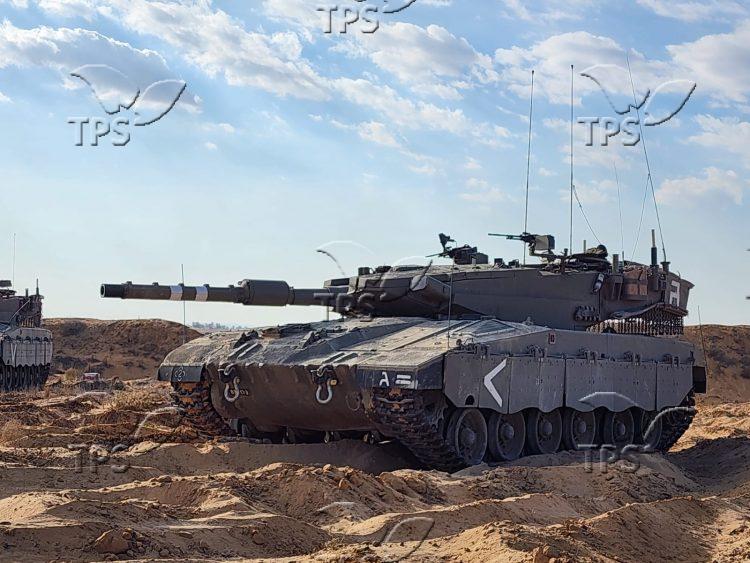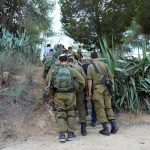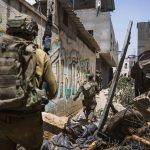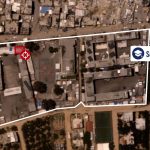Israeli Strikes Focus on Hamas Leadership; Oct. 7 Terrorists Interrogated
Jerusalem, 22 October, 2023 (TPS-IL) -- Israel is interrogating terrorists captured during Hamas’s Oct. 7 attack, and Israeli strikes on the terror group in Gaza are ongoing, according to the Israel Defense Forces.
“We’re still striking in Gaza. Our focus right now is the commanders and the leadership,” said Israel Defense Forces international Spokesman Lt. Col. Richard Hecht on Sunday.
“Last night we took out the deputy commander of Hamas’s rocket-firing array, and we are also going for specific infrastructure,” including command center and tunnel shafts, he said.
Within Gaza, the IDF is aware of some 700,000 Palestinians who have complied with Israeli evacuation calls and moved south, he said, adding, “We believe conditions are there to house those communities.” Hamas is working to prevent more Gazans from evacuating, he said.
Some 300,000 Israeli civilians have been displaced by the war, according to Israeli media reports, while the IDF has issued official evacuation orders for some 100,000 people so far in both the north and south of the country.
Addressing the next stage of the conflict, Hecht said, “We will operate at a time, place and manner that we choose, based on our operational interests.”
Meanwhile on Saturday, IDF Spokesperson Rear Adm. Daniel Hagari stated that a fifth of all rockets fired by Hamas and Palestinian Islamic Jihad, or 550, had fallen inside Gaza, with IDF assessments being that the failed launches have caused Palestinian casualties.
Hamas and Palestinian Jihad have fired some 7,000 rockets at Israel since Oct. 7, according to the Israeli military.
According to additional data provided by Hagari, there are currently 210 hostages being held in Gaza, following the release by Hamas on Friday of two hostages. So far, 312 Israeli soldiers have been killed during “Operation Swords of Iron,” according to the IDF.
Gaza Strikes Continue
Israeli fighter jets struck over 100 Hamas targets overnight Thursday, including a tunnel, weapon warehouses and dozens of command centers.
Amjad Majed Muhammad Abu ‘Odeh, a Hamas naval operative who took part in the massacre of Israeli civilians in southern Israel, was killed during the strikes, according to the IDF.
Mahmud Sabih, a senior Hamas terrorist operative who served as a top engineer and unit head in Hamas’ weapons development department, was also killed, according to the IDF.
Sabih facilitated the transfer of information to Hamas regarding the production of weapons and unmanned aerial vehicles, according to the IDF.
In addition, a Hamas terror squad was neutralized in a targeted strike in Gaza City after they attempted to fire rockets at an Israeli jet.
Terror assets and weapons located in a mosque in Gaza’s Jabalia neighborhood were also destroyed. The mosque was used as observation posts and staging ground by Hamas terrorists, according to the IDF.
“We’re still doing localized [ground] raids near the fence. And we’re preparing for future options,” said Hecht.
Hecht cautioned that “the area around Gaza is still an active war zone. Some terrorists tried to get back in.”
On Sunday, Israeli forces killed two terrorists who were attempting to infiltrate the Gaza border.
Hecht added that “there is still a very small number” of terrorists that entered the country on Oct. 7 that could still be at large.
Israel’s war aims remain the same, said Hecht.
“Our goal is to dismantle Hama’s military leadership. We’re recommending that all the Gazans move south… to open areas west of Khan Yunis.”
Lebanon, Syria and the Gulf
Meanwhile, according to a defense official cited by the Stars and Stripes website, four cruise missiles and 15 unmanned aerial vehicles were shot down by the USS Carney in the northern Red Sea on Thursday.
The attack was launched by Yemen’s Houthi militia, with southern Israel likely being the target.
Responding to the missile fire from Yemen, Hecht said that “we have a very strong posture of air defense coordinated with the Americans. They’ve shown capabilities not only in the Mediterranean but also in the Red Sea.”
U.S. Secretary of Defense Lloyd Austin announced on Saturday the deployment of Terminal High Altitude Area Defense (THAAD) and Patriot batteries to the region.
In Syria, international media reported Israeli strikes on runways at the Damascus and Aleppo airports overnight Saturday. Similar strikes were reported on Oct. 12, also attributed to Israel.
The IDF declined to comment on the reports.
On the Lebanese border, Hezbollah continued to attack targets in Israel with anti-tank missiles, with the IDF striking Hezbollah cells in response.
“We will keep responding every time,” said Hecht on Sunday, in reference to the Lebanese arena. “Lebanon/Hezbollah should not come into this. It would be very bad for them to risk their future for Hamas,” he warned.
The IDF has intercepted several UAVs from Lebanon, and an Israeli soldier was seriously wounded on Saturday by a Hezbollah anti-tank missile strike on Kibbutz Bar’am. Two other soldiers were lightly injured in the attack.
Meanwhile, the IDF has announced the evacuation of a further 14 communities near the Lebanese border, both to protect civilians and strengthen the military’s freedom of operation, according to the military.
On Oct. 16, the IDF began evacuating some 10,000 Israelis from 28 communities located within 1.2 miles of the border, expanding the evacuation to 14 additional communities on Sunday. The border city of Kiryat Shmona, which has a population of over 20,000, received an evacuation order on Friday.
Hecht assessed on Friday that Hezbollah is currently trying to deflect Israel’s resources from Gaza with its escalations on the Lebanese-Israeli border.
“Hezbollah will be held responsible for whatever they do. There is a certain language of kinetics. Some of the firing is done by Palestinians factions but Hezbollah knows about it, we assume,” said Hecht.
“Anyone who shoots, we shoot back. Anyone who tries to cross the border, we stop,” Hecht stated.
“The Northern Command is ready for any scenario. We’re at full force,” said Hecht, adding that the IDF is “trying to contain” the northern arena.
Hezbollah “knows exactly” what Israel’s threshold is, he said, citing as an example the launch of long-range rockets.
As of Friday, the IDF’s official figure for the number of hostages being held in Gaza was 203, while more than 100 people were still unaccounted for following Hamas’s Oct. 7 assault.
The hostage situation is being handled by the “most sensitive closed circuits in our intelligence circles and political echelon,” he stated.
Three-Stage Strategy
On Friday, Israeli Defense Minister Yoav Gallant told the Knesset Foreign Affairs and Defense Committee during a briefing at IDF headquarters in Tel Aviv that Israel had a three-stage war strategy.
“We are at war, we have been left no choice. Oct. 7 will be remembered as the day that started the destruction of Hamas,” he said.
“There will be three stages. We are now in the first stage—a military campaign that currently includes strikes, and will later include maneuvering, with the objective of neutralizing terrorists and destroying Hamas infrastructure,” he said.
“The second phase, an intermediate one, will require operations at lower intensity, with the objective of eliminating ‘pockets of resistance’ [remaining terror hotspots],” he continued.
“The third phase will require the establishment of a new security order in Gaza, the removal of Israel’s responsibility for life in the Gaza Strip, and the establishment of a new security reality for the citizens of Israel,” he concluded.
The committee is chaired by Knesset Member Yuli Edelstein.
Judea and Samaria
Meanwhile in Judea and Samaria, the IDF on Saturday night conducted an airstrike on an underground terror compound in the Al-Ansar mosque in Jenin. The IDF said the mosque contained a cell of Hamas and Islamic Jihad terrorists who were organizing an imminent terror attack.
The cell was responsible for a bombing on Oct. 14 in the area of the security fence, according to the IDF. No injuries were reported.
According to Hecht, “The mosque was used by the terrorists as a command center to plan the attacks and as a base for their execution.” Hamas chief in Gaza Yahya Sinwar is “trying to push Hamas to act in Judea and Samaria,” he added.
The IDF’s security coordination with the Palestinian Authority in Judea and Samaria is continuing, though it “is not what it used to be,” Hecht told the Tazpit Press Service.







